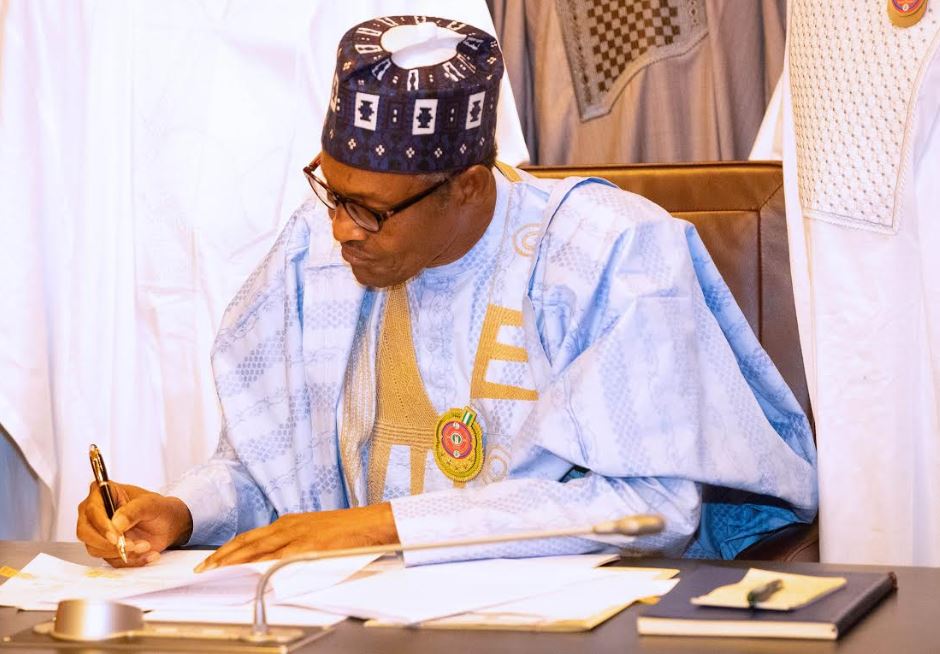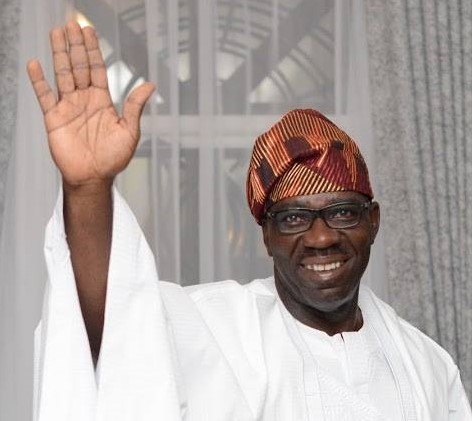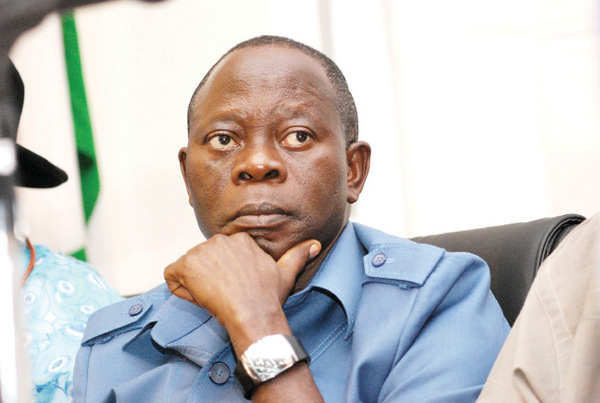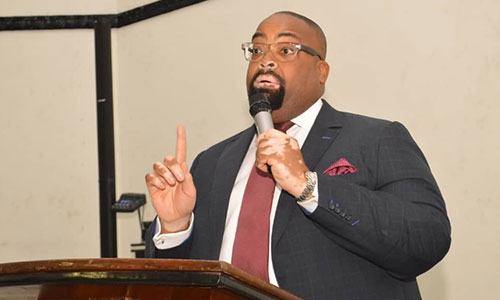President Buhari has issued another executive order. This time, his order is directed at ensuring the enforcement of a constitution provision. This order, unlike previous orders, seem to enjoy large popular support. It is important to note that oftentimes the actions that breach the constitution or lead on the path towards authoritarian rule usually enjoy significant popular support. Populism could be said to be the enemy of constitutionalism. Today’s constitutional democracy is an enemy of populism to the extent that populism is more concerned with the achievement of other values beyond or against rights. And constitutional democracy is in essence the limitation of other social goods for the protection of rights. So, we need to assess the constitutional warrant of Executive Order 20 apart from its seeming popular support.
Executive Order 10 2020 authorizes the Accountant General of the Federation to withhold monthly allocations to states from the federation account in respect of any state whose governor fails to implement the provisions of section 121(3) of the Constitution which grants financial autonomy to the state legislature and state judiciary. The Section mandates that the allocations in the state budget shall be a charge on the Consolidated Revenue Funds of the state which shall be a first line charge. The order thereafter makes subsidiary arrangements for the realization of the objectives. One of the most important these arrangements is the authorization of the Accountant General of the Federation to impound the monthly allocations of state that contravene the order. I will discuss some of these arrangements later in this write-up.
NATURE AND VALIDITY OF EXECUTIVE ORDERS:
There is no direct mention of executive orders in the constitution. Therefore, there is no express textural justification for the exercise of executive order by the President in the constitution. Executive Orders are a child of constitutional development, especially, in the history of the development of presidential power in the United States. The power of the president as the embodiment of the executive branch of government vis-à-vis the legislative and judiciary branches of government has shaped the development of constitutional law. So, although the power of the president to issue executive order are not expressly provided in the constitution, it has become a part of constitutional theory of the executive presidency. It is often linked to the concept of the ‘implied power’ of the president as a Chief Executive or as consequential aspect of the president’s responsibility to ‘enforce and execute’ the constitution.
Advertisement
Executive order takes its history from the practice of US Presidents who often issues such orders to organize the executive branch of government. One of the most notable of such use of executive order was by President Truman who issued an order to affect a private company producing steel in time of national emergency. The US Supreme Court nullified the exercise of executive power because it exceeded the extent of presidential power under the constitution. Many executive orders issued by US President have been uncontroversial as they deal with matter in which the President has clear mandate and authority to manage. Many US presidents have issued executive orders to clarity procedures and process for exercise of regulatory power by administrative agencies, otherwise called ‘executive agencies’ in the US administration law. These agencies are executive power of the president as authorized by the congress and as long as the executive does not violate the provisions of the act and does not amount to rule-making by the president under the guise of exercising executive power, then it is within the power of the president.
In essence, executive order is properly issued by the President when it enables him or her to prioritize how executive agencies implement their mandates. This will include mandating considerations which do not contradict the legislative mandate of such agencies. For example, executive order can require regulatory agencies to conduct particular kind of cost-benefit analysis before finalizing and announcing new regulatory rules. In this case, the executive order does not change the legislative mandate of the regulatory agencies but creates additional requirements of administrative nature that enables it to deliver its mandate in a manner that agrees with the priorities of the President. This is the form in which executive orders have appeared most in the constitutional history of the United States. Most of the Presidents have issued executive orders to scale back regulatory actions as a form of rolling back what is now known as the ‘administrative state’. Ronald Reagan notably issued such executive order to decrease the number of regulatory rules in order to cut back on the ‘deep state’. Bill Clinton, in his bid to reform the government, issued executive order which requested that any such additional rule must contain social and economic impact assessment.
Nigerian presidents don’t have a history of issuing executive orders. President Buhari was the first president to issue real executive orders. The more common rule by the executive branch of government in Nigeria’s democracy has been the ‘service-wide circulars’ issued by the Secretary of the Government of the Federation (SGF). The notable differences between these circulars and executive orders are first these circulars are of less legal pedigree since there are more like policy guidelines to public servants. But executive orders are legal instruments enforceable by the courts. Again, whereas executive orders expressly as part of Section 5 powers of the President, circulars are not so issued. Because executive orders derive from Section 5 powers of the president, its legality is secured. Ironically, because it derives it legality from Section 5 power of the president, its legality is also circumscribed.
Advertisement
The Nature and Extent of Section 5 Power of the President:
The position of the President in presidential system of government is so pronounced and dominant that it is often difficult to have a proper understanding of what the President can and cannot do. The complexities of modern governance have required the sort of executive expertise and authority that modern-day president exercise. This practical necessity has also often clothed the presidents with legal ornaments that are not justified by correct reading of the constitution. Africa’s leading constitutional lawyer, Professor Ben Nwabueze, captures the historical context of the emergence of the executive presidency in Nigeria’s constitutional law in his book: Presidential Constitution of Nigeria (1984) page29. Nwabueze contextualizes the adoption in the 1979 Constitution of an presidential system with the president as both Head of State and Head of government rather than the parliamentary system where the President is Head of State but not Head of Government as the imperative for effectiveness in solving complex challenges of social and economic development. The preference for an executive president is to have a chief executive who can exercise effective management of the national economy and domestic affairs as well as be the sole organ on foreign policy. As Nwabueze puts it, the imperative of national development “calls for effective leadership, leadership that would be able to mobilize the nation and its resources, and to provide purposeful direction for its people”. This model has it merits and merits. But it seems to have served better than the parliamentary system practiced in the First Republic hence the 1999 Constitution retained it.
The general perception is that the model makes the president something of an ‘elected kingship’ according to the rendering of some US scholars during early period of the US constitutional development (see Lawrence Tribe and Joshua Matz, Uncertain Justice: The Robert Court and the Law (2015)). Nwabueze has debunked any such notion and argued that the power President under the 1979 Constitution (and this applies as well to the 1999 Constitution) is limited. The power of the president under our constitutional democracy fluctuates depending on the personality and the contexts of a particular president. It is true as Edwin S. Corwin puts it that ““The history of the presidency is a history of aggrandizement, but the story is a discontinuous one. That is to say, what the presidency is at any particular moment depends in important measures on who is the president” (Edwin S. Corwin, The President (5th Edition) 1984, pages 29-30). But the extent of fluctuation is limited by the constitutional texts and legal norms, for as Justice Breyer of the US Supreme Court wisely observed in Rasul v. Bush 542 U.S. 466 (2004 “It seems rather contrary to an idea of a Constitution with three branches that the executive would be free to do whatever they wanted without a check”. In that case, the US Supreme Court rebuffed President Bush’s claim of unlimited power in the pursuit of war against terrorism. The court restated the limitation of presidential power in Hamidi v. Rumsfeld 542 U.S. 507 (2004) when it refused the president’s assertion of power to detain a US citizen without trial on terrorism charge.
The presidential power in Section 5 of the constitution is extensive but not unlimited. It is limited by the language of the constitution. Section 5 establishes the office of the president and its powers. Subsection (a) provides that the executive power of the federation is in the President who may exercise it by himself, the Vice President, a Minister, or any other public officer. This means that unless where the constitution has stated expressly, the executive power in Section is personal to the President who may exercise by himself or other aides or appointees howsoever described. Section (b) defines this personal power to “extend to the execution and maintenance of this constitution, all laws made by the National Assembly and extend to all matters with respect to which the National Assembly has, for the time being, power to make law”. The executive power extends to ‘execute and maintain (1) the constitution, (2) law made by the National Assembly, and (3) all matters which the National Assembly has power to make law.
Advertisement
Section 5 is similar to the provisions of the Article 2 of the US Constitution. The US Supreme Court has explained the extent and limits of executive power created by Article 2. In Youngstown Sheet & Tube Co. v. Sawyer (343) U.S. 579 (1952), the US Supreme Court interpreted the power of the President to issue executive order. In that case, the President issued an order that affected the fortunes of a private company in a period of emergency without congressional or constitutional authorization. The President based his power on an omnibus authority to manage the national economy and protect the strategic interest of the country in time of national emergency. The court rejected the argument and held that “The President’s power to issue the order if any, must stem from an Act of Congress or from the constitution”. The Supreme Court analyzed the legal incidences of presidency power as follows: (1) when the executive order is based on express provision of the laws; (2) when the executive order is not based on express provisions of the law; and (3) when the executive order is contrary to the Act of Congress or undermines their lawmaking power.
Explaining these incidents of executive power, the court held that the president’s exercise of executive power is strongest when it is based on ‘an express provisions of the law- the constitution or Act of Congress (in our case, Act of National Assembly) and weakest when the exercise of executive power is contrary to the law or undermines lawmaking power. On the third instance, Justice Jackson argues “When the President takes measures incompatible with the expressed or implied will of Congress, his power is at the lowest ebb for then he can only rely on his own constitutional power minus any constitutional power of Congress over the matter. Presidential claim to a power at once so conclusive and preclusive must be scrutinized with caution for what is at stake is the equilibrium established by our constitution”. In reference to when the executive order is not based on ‘express provisions of the law’ but not contrary to the law, Justice Jackson argues “When the President acts in absence of either a congressional power of denial of authority, he can only act on his independent power, but there is a zone of twilight in which he and Congress may have concurrent authority, or in which its distribution is uncertain”. Where the exercise of executive power is based on express authorization of the Congress (National Assembly), “his authority is at maximum, for it includes all that he possesses in his own right plus all that Congress can delegate”.
This logical matrix helps us to understand the extent of presidential power under section 5. The validity of the exercise of presidential power to issues executive will depend on whether it falls into which of these brackets: issued based on the express authorization of the law; issued without the express authorization of the law and not contrary to the law; and issued contrary to the law. Let us review Executive Order No. 10 in the light of this legal analytic.
THE LEGAL VALIDITY OF EXECUTIVE ORDER 10:
Advertisement
The order states that it is based on power vested on the President “under Section 5 of the Constitution of the Federal Republic of Nigeria 1999 (as amended) which extends to the execution and maintenance of the Constitution, laws made by the National Assembly (including but not limited to Section 121(3) of the Constitution as amended), which guarantee financial autonomy of the State Legislature and the State Judiciary”. This means that the power to issue the order is the power of the president to ‘execute and maintain” the constitution. From the analytic of the US Supreme Court in the Youngstown case, the power to ‘execute and maintain’ the constitution must be expressly stated so as to justify exercise of executive power to the detriment of the lawmaking process. The question to ask is whether the constitution has unequivocally bestowed on the President a responsibility to take such necessary action.
Section 121(3) of the Constitution as amended states thus: “ Any amount standing to the credit of the (a) House of assembly of the State, and (b) Judiciary; in the Consolidated Revenue of the State shall be paid directly to the said body respectively; in the case of judiciary, such amount shall be paid directly to the head of the court concerned”. This provision is clear. It does not create a direct and express obligation on the President to take any particular action to enforce its obligation on the state. The President claims power to issue executive order to enforce the constitution. The question that needs answer is whether there is any think in Section 121(3) that mandates specific presidential action to enforce. Is there any duty that requires presidential action to execute? Does the Section 5 presidential power entail ‘legislative’ enforcement by the President of a clear constitutional violation? That is, where a person or body refuses or neglects to perform a clear constitutional duty, does section 5 clause of ‘execute and maintain’ create a special legislative power for the president to issue executive order of the sort of Executive Order No. 10. The answer starts with examining the content of the order.
Advertisement
The Order begins with a preambular statement that the order is an outcome of a Presidential Implementation Committee established to “fashion out strategies and modalities for the implementation of financial autonomy for the state legislature and judiciary in compliance with Section 121(3) of the Constitution of the Federal Republic of Nigeria”. The committee and its work violate the principle of federalism in the constitution. There is nothing in Section 121(3) that gives the president the responsibility to take any action to promote the principle of financial autonomy established by the constitution. This is an encroachment into the domain of states. The federal government can change the behavior of state actors to perform best practice in fiscal governance through nudges and financial and nonfinancial incentives. But nothing permits the state governments to take action to change governance arrangements in the state or impose duties on states not based on voluntary assumption of duty. So, from the preamble, the validity of the order is doubtful from the action preceding and authorizing it, namely, the constitution of a special committee by the president to ‘fashion out strategies and modalities for the implementation of financial autonomy for the state legislature and judiciary’.
The Order further states that based on the premise of executing the constitutional provision and ensuring stable governance in the state, the President orders “allocation of appropriated funds to the state legislature and judiciary in the State appropriation law in the annual budget of the State, shall be a charge upon the Consolidated Revenue Fund of the State as a First Line Charge”. This is the same provision of the constitution. The President has no power to order what the constitution has unambiguously mandated. This is at best frivolous and redundant and at worst, a violation of the rulemaking powers of the legislature and transgression of the limits of president under Section 5 of the Constitution.
Advertisement
Even if Section 121(3) of the Constitution does not exist, it will be a gross violation of the constitutional rule preserving the legislative competence of the state for the President to prescribe duty of constitutional magnitude through an executive order. First, an executive order in a proper sense should not operate to prescribe duties on actors who are not agents and aides of the president and therefore saddled with the responsibility of executing Section 5 responsibility. Such use of executive order would amount to lawmaking. The only basis in a constitutional democracy of our kind by which rights and liabilities could be created is through lawmaking by the legislature or rulemaking by executive agencies delegated such legislative power by Act of the National Assembly. The president has no such rulemaking power. He can only issues directives in the form of administrative guidelines that define the parameters in which his aides and agents can carry our executive functions defined by either the Constitution or Acts of the National Assembly.
To enforce its ‘constitutional’ prescription, Paragraph 2 of Order No. 10 authorizes the Accountant General of the Federation to “authorize the deduction from source in the course of Federation Accounts Allocation from the money allocated to any State of the Federation that fails to release allocations meant for the State Legislature and State Judiciary in line with the financial autonomy” granted by the constitution. Furthermore, the paragraph also authorizes the Attorney General of the Federation to issue such directions for deduction to the Accountant General from time to time and the Accountant General is bound to obey. Allocations from the Federation Account to States is a constitutional right. The Order grants the Attorney General the right to order its forfeiture in order to ensure enforcement of Section 121(3) of the Constitution. How valid can paragraph 2 be in the context of both the constitutional rules of separation of power and federalism? Forfeiture of rights, especially those created and guaranteed by the constitution and Act of National Assembly can only be affected through law made through lawmaking procedure. Nothing in Section 121(3) provides for punitive actions against defaulting states or authorized the president to take such action.
Advertisement
The Order gets further mired in constitutional illegality when it imposes on the States an obligation to ‘set up a Committee from the announcement of the Executive Order comprising Commissioner of Finance, Accountant General of the State … “ that will determine a workable budget for the state legislature and judiciary. The Order even goes further to impose positive duties on the state judiciary and legislature and even on specific officials of the states. These provisions are fragrant violations of the principle of federalism. They undermine the ‘sovereignty’ of subnational governments. Sections 4, 5 and 6 of the Constitution establish the structure of governmental power in Nigeria in the manner that the two tiers of government have clear and separable schemes of power and responsibilities. These schemes are in some cases complementary, but they do not allow the direct imposition of obligation on each other’s officials by administrative or executive action.
The totality of the Executive Order No. 10 is that it imposes obligations on state governments and empowers presidential aides (Attorney General and Accountant General) to act against subnational government without clear authorization by the constitution or the act of National Assembly. In this sense, Executive Order No.10 does not fall under the first schema of the Youngstown analytics. It is not based on the express provisions of the constitution or the Act of the National Assembly. Again, it does not fall within the ‘twilight’ where National Assembly has not spoken clearly and where there is no express prohibition. The prescriptions of the Executive Order falls within the zone of constitutional prohibition.
The Nigerian Supreme Court has not decided on the constitutional validity of president issuing executive orders. But extrapolating from that court’s decision on legislative intervention in domain of state power, we can conclude that the court will nullify exercise of presidential power to the extent of impose legal obligations on states and state officials without the express command of the constitution or based on an Act of the National Assembly. In A.G. Abia v. A.G. Federation (2006) 16 NWLR (Pt. 1005) 265, the Nigerian Supreme Court nullified a law by the National Assembly that imposed duty on the state in managing its joint account with the local government. The law sought to enforce fiscal responsibility such that allocations to local government are not mismanaged by state governments. The Supreme Court held that the federal government had no powers to constrain state government without express constitutional authorization.
THE POLITICAL ECONOMY OF EXECUTIVE ORDER NO. 10:
It is obvious that Order 10 is immensely popular because it is perceived as capable of restoring democratic accountability in the states. There is no doubt that even as Nigeria’s democracy does not pass the musters, the democratic accountability does not exist in the state even in the most deformed or rudimentary sense. So, it appears beneficial to federalize solution to the problem of constitutional governance in the states. The logic of permitting the federal government to constrain the subnational government through such ‘legislative’ intervention in the guise of executive action could be compelling. The states are politically captured by the state governors such that the beneficiaries of the constitutional mandates of financial autonomy are the persons and institutions that have gleefully abdicated it. The state assemblies across the states are no better than state executive councils in terms of independence. State legislators mostly consider themselves aides of the governors despite what the constitution declares.
The language of the Section 121(3) of the Constitution is clear and self-executory. It does not require additional legislative or executive action to implement. It makes illegal for any state budget to be passed except it makes provisions for the legislature and the judiciary as a first line charge. The provision is to the advantage of the state legislators who also have the power of sanction through impeachment. All that is required is for the state assembly to utilize its oversight power to ensure compliance. So why is this not happening? Why are the legislators abandoning their power abdicating their responsibility?
There is a powerful incentive behind this terrifying self-abnegation. Financial autonomy would mean that statutory allocation for legislature will go to the head of legislature and be used mostly by the bureaucracy of the state assemblies to make them functional and efficient. The legislators will have marginal financial gain. Mostly, the bureaucrats at the assemblies will have more gains. But the present circumstance where the Governors extra-budgetarily give money to the legislators based on continued loyalty and support may be financially more rewarding to the legislators. So, state legislators may not reckon much with so-called financial autonomy. Again, many of these legislators got elected on the back of the governors’ social and financial capital, they do not have any reasonable pedigree and cannot afford to run for a second term on their own strength. The implication of this analysis is that ensuring financial autonomy of the state legislature needs more than constitutional amendment and executive order. It needs a democratic reform starting with electoral reform and reconstituting the political dynamics of the states. If there is no effective political competition; if elections are not free, credible and competitive; and if state governors easily capture the states and their resources, autonomy for state institutions will be very difficult. Interventions like the president’s executive order will merely expand the President’s power and undermine the prospect of constitutional governance, which is limited government.
CONCLUSION:
Despite the intentions and sentiments of the president and his aides, the recent executive order is an unlawful exercise of Section 5 powers of the President. Although the president has the power to enforce and execute the constitution, any exercise of such power must derive and relate to any express grant by the Constitution or an Act of the National Assembly. No such exercise that usurps the lawmaking functions of the legislature or encroach on the ‘sovereignty’ of subnational governments. Executive Order No. 10 is not a valid exercise of the executive power of the President. It is both unconstitutional and dangerous.
Views expressed by contributors are strictly personal and not of TheCable.







